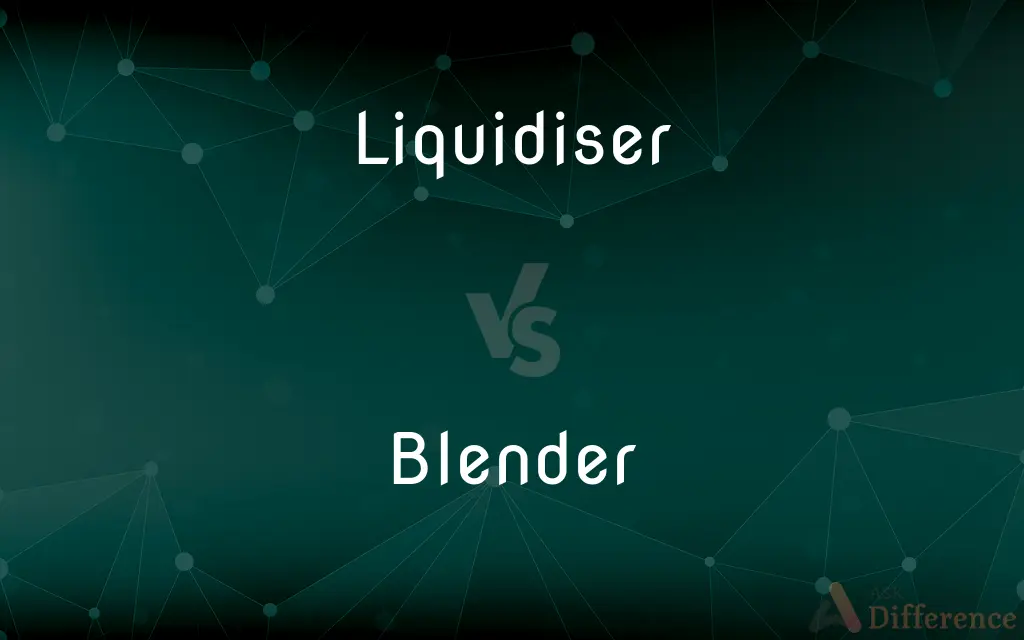Liquidiser vs. Blender — What's the Difference?
Edited by Tayyaba Rehman — By Fiza Rafique — Updated on November 6, 2023
A liquidiser (British term) and a blender (American term) are both appliances for mixing ingredients into a liquid form, often used interchangeably.

Difference Between Liquidiser and Blender
Table of Contents
ADVERTISEMENT
Key Differences
Liquidisers, known predominantly in British English, and blenders, their American counterparts, are both kitchen appliances designed to puree, emulsify, and mix food and other substances. Each is equipped with a blade and motor to rotate at high speeds, allowing the breakdown of solid ingredients into smoother mixtures. The primary function is to introduce a liquid consistency to various components, aiding in the preparation of soups, sauces, and drinks.
While the term liquidiser might imply an appliance specifically adept at handling liquids, both liquidisers and blenders can generally perform similar tasks. Blenders, however, are sometimes perceived to be more versatile, often used for a range of textures from smooth liquids to thicker purees and even doughs in some high-powered models.
In terms of design, liquidisers often have a jug with a tight-fitting lid and a base containing the motor, as do blenders. High-powered versions of both may include additional features for processing hard ingredients like frozen fruits or ice, suggesting that the distinction is less about capability and more about regional terminology.
The cultural preference in naming may also reflect the typical uses within those regions. For example, in the UK, a liquidiser might be more commonly associated with soup preparation, while in the US, a blender is often synonymous with making smoothies and blended cocktails.
In summary, both a liquidiser and a blender serve the same essential purpose in the kitchen, which is to blend ingredients to the desired consistency. The choice of term often comes down to regional dialect rather than a difference in function.
ADVERTISEMENT
Comparison Chart
Terminology
British English term
American English term
Primary Use
Pureeing, emulsifying liquids
Blending various textures
Design
Jug with lid and base with motor
Pitcher with lid and motor base
Power
Variable, with high-powered options
Variable, with high-powered options
Regional Usage
More common in the UK
More common in the US
Compare with Definitions
Liquidiser
An appliance for pureeing foods into a liquid state.
The chef recommends a powerful liquidiser to prepare fine sauces.
Blender
A machine used to create smoothies, soups, and sauces.
The new blender is capable of crushing ice for frozen drinks.
Liquidiser
A tool to emulsify or blend food substances.
The liquidiser was essential in creating the perfect smoothie.
Blender
A gadget designed to liquefy, mix, or chop food.
She used the blender to chop nuts for the cake topping.
Liquidiser
A machine for making liquids out of solid food.
I used the liquidiser to turn the vegetables into a smooth soup.
Blender
A kitchen device with spinning blades for mixing.
For this recipe, use a blender to combine the wet and dry ingredients.
Liquidiser
A kitchen device for blending ingredients.
She put the fruits into the liquidiser to make a fresh juice.
Blender
A versatile appliance for culinary tasks like pureeing.
The blender’s different speed settings made food prep easier.
Liquidiser
An electric gadget that homogenizes food.
To clean, he detached the liquidiser's jug from its motor base.
Blender
An electric appliance for mixing and pureeing foods.
I threw all the ingredients into the blender for a quick mix.
Liquidiser
Standard spelling of liquidizer
Blender
A blender (sometimes called a mixer or liquidiser in British English) is a kitchen and laboratory appliance used to mix, crush, purée or emulsify food and other substances. A stationary blender consists of a blender container with a rotating metal blade at the bottom, powered by an electric motor that is in the base.
Liquidiser
An electrically powered mixer with whirling blades that mix or chop or liquefy foods
Blender
A person or thing that mixes things together, in particular an electric mixing machine used in food preparation for liquidizing, chopping, or pureeing.
Blender
One that blends, especially an electrical appliance with whirling blades for chopping, mixing, or liquefying foods.
Blender
A machine with sharp rotating blades in a bowl, for mashing, crushing, or liquefying food ingredients.
Immersion blender
Blender
(theatre) A piece of fabric sewn into the front of a theatrical wig to make it blend in with the performer's natural hair.
Blender
(quilting) A subtly patterned fabric printed in different shades of a single color, often used in place of a solid to create visual texture.
Blender
One who, or that which, blends; an instrument, as a brush, used in blending.
Blender
An electrically powered mixer with whirling blades that mix or chop or liquefy foods
Common Curiosities
Can a liquidiser crush ice?
Many modern liquidisers are capable of crushing ice, though not all.
What is a blender?
A blender is an appliance that mixes, purees, and chops food.
What is a liquidiser?
A liquidiser is a British term for an appliance that blends food into liquids.
Can I make smoothies in a liquidiser?
Yes, you can make smoothies in a liquidiser.
Is there a difference between a liquidiser and a blender?
The main difference is the term usage; functionally, they are the same.
Are blenders and liquidisers interchangeable?
Yes, in terms of their function, they are interchangeable.
What should I look for in a good blender?
Look for power, blade quality, and speed settings in a good blender.
Can blenders be used to make dough?
Some high-powered blenders can be used to make dough.
Do liquidisers have different speed settings?
Yes, many liquidisers have multiple speed settings.
How important is wattage in a blender's performance?
Higher wattage typically indicates more powerful blending capabilities.
Why use a liquidiser instead of a food processor?
Liquidisers are better for creating smooth liquids; food processors offer more texture.
How do I clean a liquidiser?
Clean by disassembling the jug from the motor and washing the parts.
What can't you put in a blender?
Extremely hard items or hot liquids can be unsuitable for some blenders.
Are all blenders able to heat soups?
Only blenders with a heating function can heat soups as they blend.
Can I blend hot ingredients in a liquidiser?
Check the manufacturer's guidelines, as not all liquidisers are designed for hot ingredients.
Share Your Discovery

Previous Comparison
Chorus vs. Chorale
Next Comparison
Trousers vs. TrouserAuthor Spotlight
Written by
Fiza RafiqueFiza Rafique is a skilled content writer at AskDifference.com, where she meticulously refines and enhances written pieces. Drawing from her vast editorial expertise, Fiza ensures clarity, accuracy, and precision in every article. Passionate about language, she continually seeks to elevate the quality of content for readers worldwide.
Edited by
Tayyaba RehmanTayyaba Rehman is a distinguished writer, currently serving as a primary contributor to askdifference.com. As a researcher in semantics and etymology, Tayyaba's passion for the complexity of languages and their distinctions has found a perfect home on the platform. Tayyaba delves into the intricacies of language, distinguishing between commonly confused words and phrases, thereby providing clarity for readers worldwide.















































